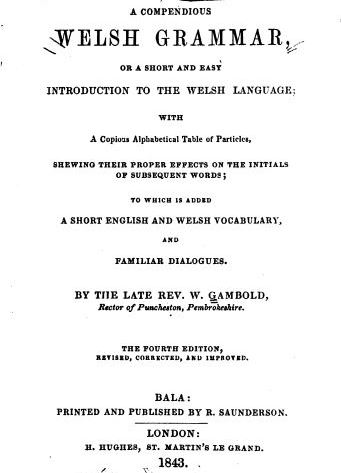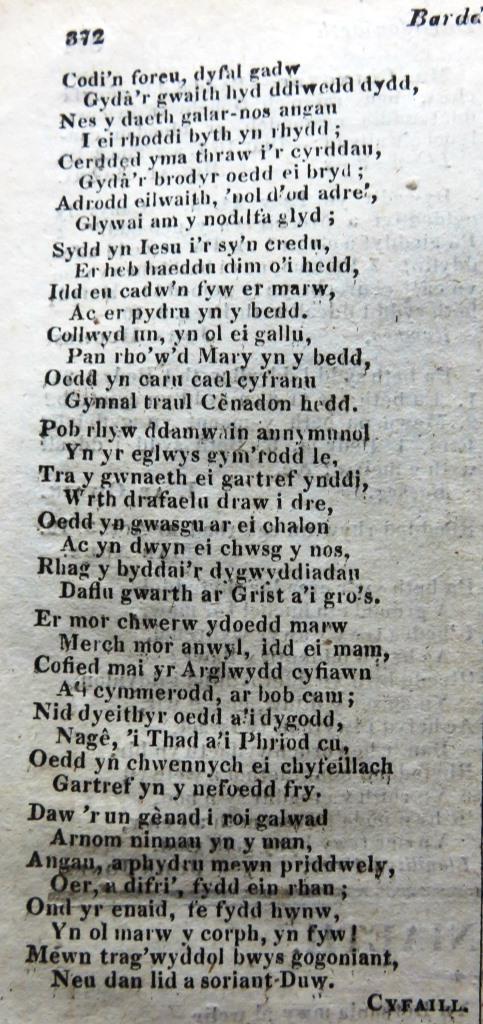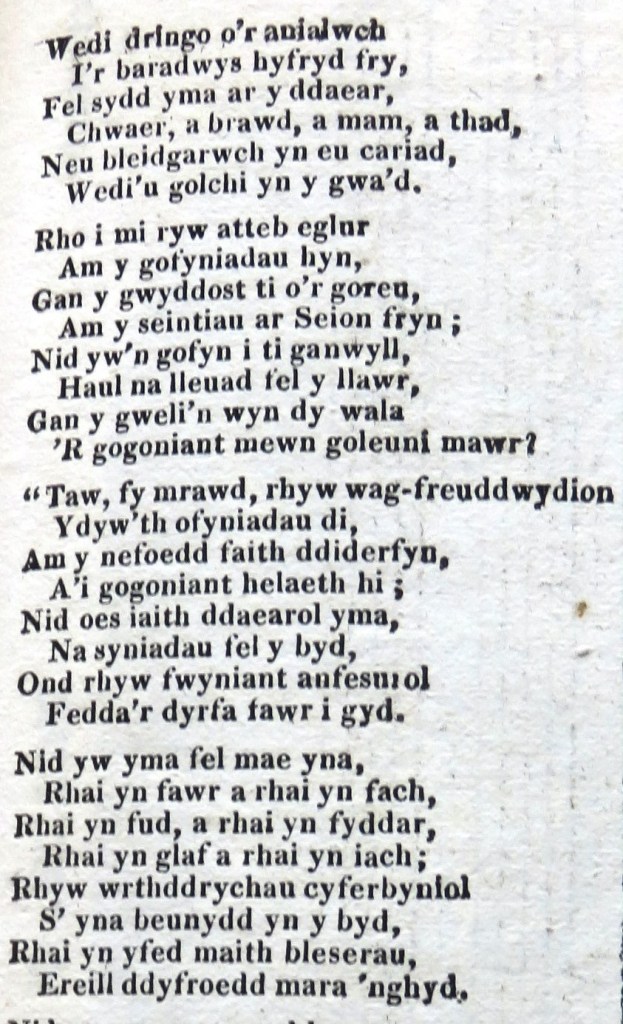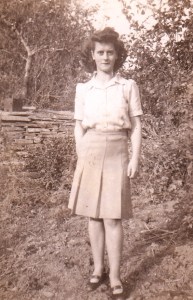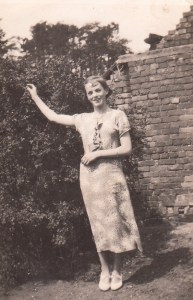Bethania, Capel Mair, Tabernacl, Mount Zion or Hope Chapel?
Category: Cardigan History
Who were members of the Maesglas Nappy Gang?
Cardigan People 49: Ronnie Rees, y glo (1938-2021)
Have your Say! CARDIGAN MEMORIAL HOSPITAL PUBLIC CONSULTATION 25, 26, 27 Feb.
It’s not fair! (11.2020)
No Fair this year due to the Coronavirus pandemic. According to sources Cardigan’s Fair has an unbroken history dating back as far as 1302 – until Covid-19 put a stop to the record, but there was no Fair on 10 November 1861 either – because the 10th was a Sunday!

What was Fair day like? Well here is W. Davies, Crundale school (Goglwyd, Llangoedmor writing in the Tivy-side, November 1913 about Fair Day c. 1860s:
Finch’s Square was full, if not overcrowded, and the first that attracted my attention was the most important man in the fair – Will Bowen, the ballad singer. He was singing ‘Marchnad Abertawe’ , followed by ‘O, wel te’n wir!’. Going up ‘Street Newydd’ (now Priory Street), there was old ‘Fanny Gingerbread’ – better known as ‘Fanny hit my legs’ – shouting to draw attention to her pile of gingerbread… Next to her were two peep shows. Close by was Mrs Jackson’s sweet stall (losin rownd a loshin hir); halfpenny a try. There was a standing of nuts; these were to be shot for, half-penny a shot. Coming down from High St was old Robin selling pins.
Later in the evening you would see sitting by the fireside of the Lamb Inn the ballad singer, challenging anyone to sing the ballad ‘Morgan Bach’ correctly from beginning to end. The challenge was taken up by a young man from the Mwldan. He sang according to the adjudicators – old Tom the Trumpeter, Shemi the Hatter and Dai Gof Cilbronnau – quite correctly, better than Will himself. This verdict roused the ballad singer’s ire, and he left in disgust for the Red Lion, where he was followed by some of his admirers.
One would not leave the Fair without buying some rice pudding from an old friend at the corner…
Happy days… and the fun continues. Many thanks to Keith Ladd for the valuable photographs.











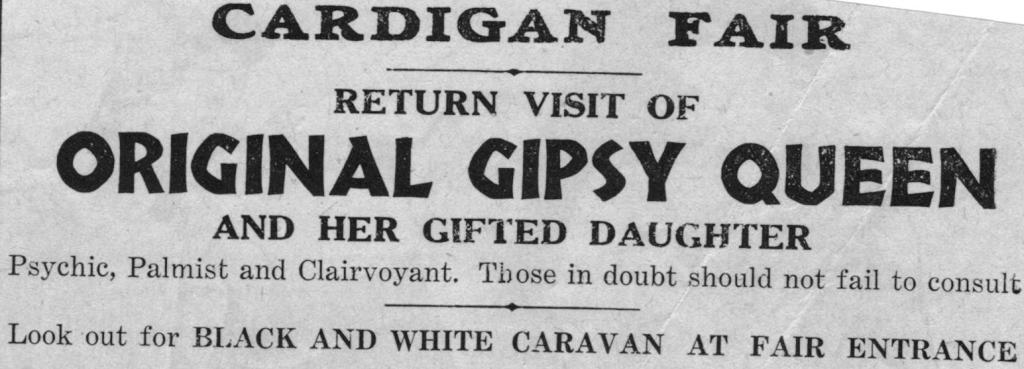
What do you remember about Fair Day?
Cardigan People 40: Sir Lawrence Hugh Jenkins (1857–1928)

son of R. D Jenkins, The Priory and also Cilbronnau, Llangoedmor
As far as I can see there is no mention of him in the Dictionary of Welsh Biography. But according to the Oxford Dictionary of National Biography Lawrence Hugh Jenkins was born on 22 Dec 1857 at The Priory, Cardigan. He was the younger son of Richard David Jenkins and the only child of R D Jenkins’s second marriage with Elizabeth, daughter of Thomas Lewis, Machynlleth, a surgeon in the Royal Navy. His birthplace is confirmed in the 1861 census return which states that he was born in Cardigan (and not Llangoedmor!).
Lawrence Hugh Jenkins was educated at Cheltenham College (1869–77); Oxford and called to the Bar Lincoln’s Inn in 1883. The Admission Register of Lincoln’s Inn for 11/11/1879 reads: “Laurence Hugh Jenkins of Univ Coll., Oxford (21), the youngest son of Richard David J., of Cilbroan, co. Cardigan, sol. JP.” He was called to the Bar: 17/11/1883.
In 1892 Lawrence H. Jenkins married Catherine Minna Brown, daughter of sugar plantation owners, of Natal.
He then became Chief Justice of Bombay High Court for ten years (1898-1908). Jenkins was also selected as Member of the Council of India.
John Morley (Liberal secretary of state for India) described Laurence as:
one of the two or three most valuable men of my Council. He is a remarkably clear-headed man, with a copious supply of knowledge in law, as well as of political imagination … a fine fellow … of immense value to me about Reforms.
He was knighted on 17 August 1899. From 1909 to 1915 he was the Chief Justice of Calcutta High Court. He also served as District Grand Master of Freemasons for Bombay and Bengal.
In his judgeship Jenkins delivered several verdicts in high profile conspiracy and bombing case including Alipore Bomb conspiracy case
Jenkins retired in 1915 and in 1921 the Right Honourable Sir Lawrence Hugh Jenkins of Cilbronnau was President of Cardigan Agricultural Show. It was held at Stepside – a successful show with over 400 entries.
In 1923 Sir Lawrence Hugh Jenkins, Lady Jenkins and Clodrydd Jenkins lived at Cilbronnau mansion. In January 1924 he was appointed Chairman of the Cardiganshire Sessions.
S. V. FitzGerald, in the Oxford Dictionary of National Biography, sums up his character and contribution:
Jenkins’s legal equipment when he first went to India was a keen dialectical mind, a thorough grasp of English equity principles, and a power of expressing himself in clear and forcible English. He soon added a mastery of Indian law and custom astonishing in one who did not visit India until his thirty-ninth year and then served only in Presidency towns; many of his finest judgments enlightened dark questions of Hindu law. He was business-like in administration, and men he chose for high responsibility justified his choice.
A sociable man, Jenkins successfully devoted himself to breaking down the barriers then separating British and Indians, especially in the Presidency towns. He came to know the leading Indian moderate politicians, and sympathized with their aims.
He died at his home in London on 1 October 1928. A Memorial window to Sir Lawrence Hugh Jenkins was unveiled at Llangoedmor Church on 7th December 1930.
(Can anyone contribute a photograph, please?)
Cardigan People 39: William Gambold (1672–1728)
According to his son writing in the preface to the first edition of John Walters’s English-Welsh Dictionary), he was born in Cardigan on 10 August 1672, ‘of reputable parents’ who destined him for the church and gave him good schooling.
But according to Foster (Alumni Oxon.) he was eighteen, ‘pauper puer,’ son of William Gambold of Cardigan, when he matriculated at S. Mary Hall, Oxford, 23 May 1693. He migrated to Exeter College in 1694, but there is no record of graduation.
In 1707 he was keeping a school at Llanychaer, and on 1 December 1709 he became rector of Puncheston with Llanychaer, Pembs.
At Oxford he had been a friend of Edward Lhuyd who acknowledges help given to him by Gambold in preparing his additions in Gibson’s edition of Camden’s Britannia.
A series of letters he wrote from Cardigan to Edward Lhuyd at Oxford between 1693 and 1697 appear here:
They refer to various archaeological finds at St Dogmaels and Nevern. Unfortunately there is no indication of where in Cardigan he lived.
As early as 1707, Gambold was planning a Welsh dictionary, and this became his main occupation later on, when an accident disabled him from parochial work. It was finished in 1722, but Gambold failed to get money to publish it until 1727 as A Grammar of the Welsh Language. A second edition was published in Carmarthen in 1817, an a third in Bala in 1833.
He died 13 September 1728. His will appears here:
https://www.genuki.org.uk/big/wal/CMN/CmnWills#Gambold1728
“To [my] eldest son, John Gambold, all that whole little Burage of mine, together with each and every stable, Outhouses, Offices, Back-sides and Gardens, unto the same belonging, situate, lying and being in the Town of Cardigan…”
William Gambold left a wife Elizabeth, four sons and one daughter.
Cardigan People 38: Margaret Nicholas (1750–10.10.1829)
Cardigan People 37: Mary Owen (1769–13.9.1829)
Cardigan People 36: Mary Davies (d. 29.7.1829)
Cardigan People 35: S. Williams (1777–17.1.1832)
S. Williams, merchant who died in 1832, a few years before the first Census in 1841. A prominent Baptist in the town. No indication where he was buried.
Cardigan People 34: Thomas Thomas (1812–18.02.1831)
Nineteen year-old Thomas Thomas died at 1 o’clock on 18 February 1831 suffering from the ‘Covid-19 of his time’ (TB). He was employed as a typesetter in the Cardigan offices of the Baptist journal Greal y Bedyddwyr. It is fitting then that a 29-verse moving tribute by his father George (who was a printer in the Greal offices) should appear in a later issue of the journal in 1831. George lived to see his 81st year and died on 12 Sept 1868. Thomas’s mother’s name was Ann. She died on 21 May 1853, and was 63 years old. They were all buried in St Mary’s Church cemetery.
Yr oedd yn ddyn ieuangc hardd, syml, hynaws, moesol, charedig; yn blentyn ufydd a gostyngedig i’w rhieni, ac yn was ffyddlawn a didwyll i’w feistr… Yr oedd wedi cyrhaedd i gryn wybodaeth o’r iaith Gymreig, ac o’i gelfyddyd; a phe buasai yn cael rhagor o fywyd a iechyd, buasai yn debyg o ddyfod yn ddyn dysglaer.
‘He was a handsome, simple, kind, and principled young man; an obedient and humble child to his parents, and a faithful and honest servant to his master… He had attained much knowledge of the Welsh language and his craft; and if he had lived a longer, healthy life he would no doubt become a brilliant man.’
Cardigan People 33: Mary Phillips (1770–1830)
Greal y Bedyddwyr, 1830
Cardigan People 32: Evan Lloyd Mathias (1801–19.02.1830)
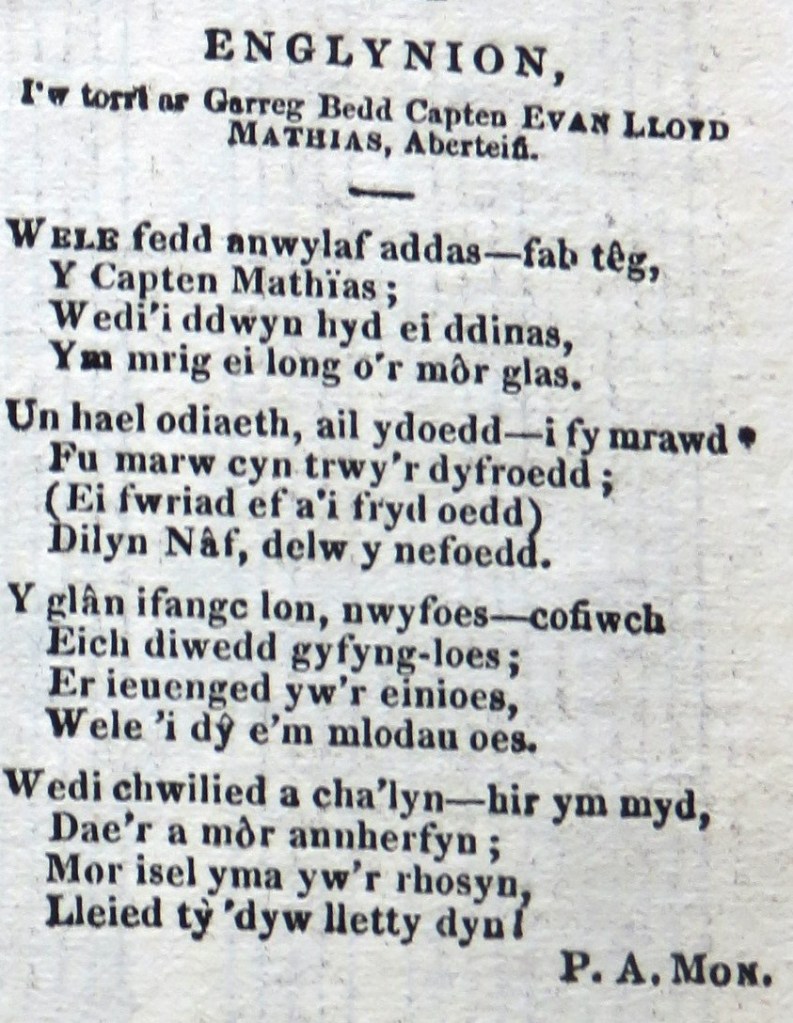
The verses mourn the loss of a young mariner. He was buried in St Mary’s Church cemetery.
Cardigan People 31: Revd John Herring (1789–1832)

Revd John Herring was the minister of Bethania Chapel from 1811 until 1832. He died after an illness that lasted some months. He left a wife and 7 small children. What else do we know about him?
The piece in the Dictionary of Welsh Biography can be read here:
https://biography.wales/article/s-HERR-JOH-1789
Well there is a story that one fine summer’s day in July while he was on one of his preaching tours in north Wales, he met the famous Revd Christmas Evans who took one look at him and said “What a strange thing to see a herring on top of a mountain”. Quick as a flash Herring replied “ Surely not more than to see Christmas in the middle of summer?” Touche as they say.
In another version the two were on top of the Frenni Fawr. By 1909 the story had changed a bit:
Christmas Evans and John Herring meet. When Mr Herring saw his friend, he shouted ‘Strange, strange, to come across Christmas in the middle of summer.’ ‘Yes, it is’, replied Mr Evans, ‘but stranger still to meet a live herring on top of a mountain.’
His unusual surname was an opportunity for many a story: Once, down in Llanboidy, he was preaching so eloquently that Mr. Powell, Maes-gwyn, a prominent local man asked ‘Who is that? ‘Herring, Cardigan’ was the reply from someone sitting nearby. ‘No, not a herring, he said but a Salmon.
But there is more to the Revd John Herring than an unusual surname.
In 1836, four years after his death D. Roberts, Llandiloes, published a booklet entitled: Derwen Wylofain.

The short biography included reveals a little of his background:
John was born to Thomas and Sarah Herring, Llanyspyddyd, Breconshire in 1789. His father died when John was 4 or 5 years old. His mother remarried and the family moved to the iron works at Ebbw Vale. John was employed at the local blacksmith.
His humorous character was revealed early on. ‘How many sects are there?’ he asked his employer one morning.
‘I think there are five of any use, and those five are in our house. My stepfather is Indepenent, my mother a Methodist, I will go to the Quakers and I’ll make my cat a Wesleyan and the little dog a Baptist’. Indeed he took his dog with him one Sunday morning to see a baptism in the Sirhowy river by Tredegar deciding to throw the dog in the river when the Revd Edward Davies was preaching. But it was not to be. Listening to the sermon he became a believer and it was he who was baptised and not the dog. He became a member of the Baptist Church at Tredegar in 1804. [Siloh says Revd. B. James (Edwards, Bethania, p. 30)]
The rest, as they say, is history…
He began preaching when he was 16 years old. Under the influence of the Revd John Hier, Basaleg, he was accepted as a student in the Colege at Bristol when he was 20/21 years old. He had had enough after a year. ‘What is the use of Hic, Haec, Hoc, to save souls’
On a preaching tour he was invited to Bethanis and accepted a calling in 1811. He remained there until his death in 1832.
- He was an exceptional preacher.
“he was one of the funniest and most popular preachers of his day”
“he was possessed of a prolific understanding, a multitude of words, a natural and effective eloquence, a tenacious memory, proper gestures, a melodious voice
But he wasn’t a perfect man ‘despite his excellent qualities he was not without his weaknesses’ (these are not listed).
- He was an excellent organiser. He drew up a list of rules and regulations on to how to organize a Church in a pamphlet entitled: ‘‘Penderfyniadau i’w gosod mewn gweithrediad yn Eglwys y Bedyddwyr yn Methania, Aberteifi, a fabwysiadwyd mewn Cyfarfod a gynhaliwyd Tachwedd 18fed, 1829,’ [Decisions to be undertaken at Bethania Baptist Church, Cardigan, and adopted in a Meeting held on 18th November, 1829’]. He elaborated on many issues: Covetousness–its harm; Generosity–its appeal; Ministers–their maintenance; The Poor–how they should be considered; Discipline–its rule; the neglect of assembling.
- He was a litterateur: He edited the Greal y Bedyddwyr for a year, and then for a further two years with J. M. Thomas.
He died at Llwynpiod, Cardigan on 2 April 1832, after an illness that had lasted some months. He was buried at Cilfowyr.
He married twice. First to Elizabeth, the daughter of the Revd Griffith Davies, minister of Rehoboth. She died in 1823 leaving three daughters: Mary, Elizabeth and Anne. His second wife was another Elizabeth (Lewis, Crugmor.) They had four children from this marriage.
His second wife died a fortnight after John leaving seven orphans – among them:
Ann, 12 year old (blind and of unsound mind); Dinah, 8 year old (later married James Morse, Trehowell); James, 7 year old. He is listed in 1901 as a retired mariner and living in Northgate Tce. He had married the daughter of the Revd. T. J. Morris and was a member of Capel Mair. He died in 1907; Sarah, 4 year old; Eleanor 2 yea rold. She is listed in 1851 as a housekeeper in Quay St; in 1861 as a housemaid in St Mary St (to Thomas Morgan, solicitor). She was a member at Bethania and died in 1898.
A number of prominent people from the chapel and surrounding district established a fund to help the children.
David Mathias, Cardigan
Timothy Thomas, the elder
William Richard, Penyparc
Daniel Davies (Independent minister), Cardigan
John Morgan, Blaenffos
Daniel Davies, Swansea
Awdl Bryddest Farwnadol i’r diweddar Barch. John Herring, Aberteifi: An elegy to the late Revd John Herring, Cardigan by Asaph Glyn Ebbwy (Thomas Williams, Tredegar). Please see the Welsh version for the 30 verse elegy!
Cardigan People 30: Owen Beynon Evans (1853–1920)

Here is an interesting portrayal that appeared in Papur Pawb 23 June 1900 in a series entitled ‘Mae sôn amdanynt’
From the time of the Carpenter in Nazareth until the present, few prophets receive honour in their own country. But now and again, there are a few exceptions such as the cheerful character portrayed below.
Owen Beynon Evans was born in Cardigan in 1853, the son of D. Beynon Evans, cabinet maker, in the capital city of Ceredigion. Owen was raised in the same profession as his father…
Catherine Row was his place of abode in 1891. He died in Delfryn, Napier St. in 1920.
“He established an enterprise on his own in 1878, and he has expanded the business annually since then so that by now it attracts many eager to buy furniture of a superior quality.
He has spread his influence in favour of every worthy cause…
He has a high cultural mind…
He is one of the children of the Sunday School and literary meeting…
He has won many Eisteddfodic prizes for essays…
He has acted as adjudicator on many occasions…
He has written extensively to local newspapers and published many articles…
He has been a temperance supporter from his youth and has associated himself with the Good Templar Movement since it was founded in the town…
He has served in many of the main posts of the Teml Teifi branch…
He works tirelessly to win youngsters over to the cause of sobriety…
He is a faithful member of the Oddfellows and has been the secretary of the Carn Ingli (Trefdraeth) branch…
Town councillor since 1884; alderman in 1895; chairman of the treasury committee.
Mayor of Cardigan in 1889–90… Justice of the Peace…
Member of the committee for the free library…
He has a keen interest in the town’s schools, one of the governors; a supervisor of the S. Kensington Science and Arts Department when local exams take place…
A prominent member of the County Council…
An important member of the Burial Board and the ‘Gwbert Syndicate’, which exists to make Gwbert-by-the-sea an attractive place…
One of the directors of the Cardigan Mercantile Company.
A thorough Liberal and member of the town’s Liberal Club…
A member of Capel Mair, deacon, Sunday School Supervisor; he has ensured an annual feast of tea and bara brith for the youngsters…
There is no-one more kind and cheerful; idleness is not in his nature, nor is he narrow in his ways, and he fully deserves the accolades he receives.
May he long stay on the banks of the Teifi, to help develop the land of the Cardi, and to make Wales a better place.
People like this are rare…
Cardigan People 29:

Mari Smith (Jones),
St Mary’s St, c. 1930s. d. 2006.
Teifryn Roberts, Meredith Davies, Alun Roberts, Eben’s Lane, 1930s 
Margaret Thom,
Paris House,
on the bridge, 1943
Daisy Thomas,
St Mary’s St., 1942
Viola Williams,
Grosvenor Hotel
On Reverse: ‘Best wishes from Sage’.
Sage Williams, wife of James, hairdresser, 1861, 33 High St., perhaps?
Cardigan People 27:
Cardigan People 26: John B. Ferrier J.P. (1843–1911)

“From Catherine Row, Cardigan to Cardiff City Hall”
John Ferrier left Catherine Row, Cardigan as a 13 year old in 1856. His father, also John, was a master mariner. John (jr.) began his Cardiff career in the offices of Messrs. George Insole and son. He migrated to the firm of Burnyeat, Brown and Co. – one of the most prosperous in the Welsh Coal Industry. He became general manager by 1873, and later managing director. Associated with the firm of Messrs. Watts, Watts and Co, (Ltd) and the United National Collieries (Ltd) they owned the Insoles-Merthyr pits and the Ynysddu collieries in the Sirhowi Valley, which together had an output of one and a half million tons of coal per annum.
J. B. Ferrier took a prominent part in Cardiff Chamber of Commerce: vice-president in 1886, 1893; president in 1894 and again vice-president in 1897. He was one of the most energetic promoters of the Cardiff Exhibition of 1896. Mr Ferrier frequently appeared before Parliamentary Committees as a witness in connection with the railways of the coalfield.
He also found time to devote his services to the Cardiff Infirmary, and was a member of the management committee for many years.
At one time he was a director of the Newport-Abercarn Steam Coal Company (Ltd) and the Stranaghan and Stephens’ Stores (Ltd) but resigned these owing to the increasing calls in his own company. He was also a director of John Williams and Son (Ltd).
From 1896 he was a vice-president of the Liberal Unionist Association and was an ardent Tariff Reformer. He retired in 1910, and died in a nursing home in Llandrindod Wells. He was cremated at Liverpool crematorium.
Information from the Evening Express 29 Sept., 1910
Cardigan Streets (and some people) 25: yesterday and today
Something a little different this time:
Cardigan? Hasn’t changed a bit.
A quick glance at John Speed’s 1610 map of Cardigan confirms that the basic layout of the High Street and principal side streets of the town have not changed in over four hundred years. However, consideration as to the usefulness of various buildings have ensured that changes have occurred over the decades…
Follow the link to read the rest:
CARDIGAN? HASN’T CHANGED A BIT?
Posted on 3 July 2020 by Archifdy Ceredigion Archives
A guest blog by William Howells, the former County Librarian and a native of Cardigan.
Cardigan People 24: Owen Roberts, Feidrfair, sailor, cook (1848–1904/05)
A note in Bethania Chapel Minutes first brought Owen Roberts to my attention. Under a list of deaths for 1905 is the following:
Owen Roberts, Feidrfair. Hwyliodd o China i Vladivostock Hydref 1904. Ni chlywyd dim oddi wrthynt drachefn yn yr SS Claverdale.
[He sailed from China to Vladivostock in October 1904. Nothing more was heard of them in the SS Claverdale]
A bit of Googling revealed a few interesting items.
Under the heading ‘Fate of the Claverdale’ the Evening Express published the following account on 31 January 1905:
A boat belonging to the overdue British steamer Claverdale has been picked up and taken to Fukuyajna. None of the crew was on board. The Claverdale left Barry on September 1 for Manila, with a cargo of between 5,000 and 6,000 tons of coal on Russian account. On October 29 she was reported at Sabang, and on November 23 left Hong Kong for Vladivostok. Nothing has been heard of her since, and it is presumed that in running the blockade she kept in too close to the land and struck a sunken rock. Captain Thomas, the master of the Claverdale, is a native of Cardigan, and is well known in Cardiff shipping circles.
The Claverdale was the pioneer ship of the Claverdale Steamship Company (Limited), owned by Messrs. E. Haslehust and Co., who claimed that this is the first vessel they had lost. She was built in 1899 by Messrs. Graig, Taylor, and Co., of Stockton-on-Tees, is 330 feet long, with a 45 feet beam, and a draught of 18 feet, while her engines registered a nominal horse-power of 278.
[Correction gratefully received from Mr Reg Nash: “the Claverdale Steamship company, owned by E. Haslehust (not Hazelhurst) and Co., had two ships called the Claverdale. The one you mention was sold in 1903 and replaced by a second, built by J. Priestman & Co. of Sunderland. This new Claverdale was launched on May 31 1904. She was 345 feet long and 48.8 feet in beam, with a draught of 20.9 feet; her nominal horsepower was 357 (National Archives BT 110/116/30). I have a copy of the blueprint plans, courtesy of the National Maritime Museum. It was her maiden voyage that ended so tragically.]
By 09 September 1905 the Cardiff Times reported that a Vladivostok telegram dated August 31st stated that a steamer stranded north of Olga was reported to be the missing British s.s. Claverdale, bound from Cardiff to Vladivostok via Hong Kong.
But further inquiries found that the rumour was not true and the reporter on the Cardiff Times was not happy:
This is the second time that such a report has been cabled home from Vladivostok respecting the same ship, and it is unfortunate that the authorities do not make an effort to secure the name of the stranded vessel before telegraphing to England.
The mystery of the missing ship seemed to have been solved by November 1905, according to a report in the County Echo, quoting the Daily Chronicle:
Dispatches received in London reveal for the first time the identity of the wreck which has frequently been sighted to the south of Vladivostok, near the mouth of the Tandse River. The vessel turns out to be the British steamer Claverdale, which left a Chinese port last November with a full cargo of coal for the Russian cruisers at Vladivostok, and which has not since been heard of. As the result of a visit paid to the stranded steamer, it has been ascertained that the vessel has been pillaged by the natives in the neighbourhood, and every article of value taken away. The inhabitants residing in the vicinity, who were interrogated, declared that the crew of the Claverdale’ were removed shortly after the wreck by two boats presumed to be Japanese.
But the missing crew remained missing : Neither owners nor relatives, however, have heard from any of the men. By November 1905 the headline in the Weekly Mail suggested that worse was to come.
WRECK OF THE CLAVERDALE: SUPPOSED MURDER OF MEMBERS OF THE CREW.
The crew who are supposed to have been killed on the Manchuria coast, where the ship was wrecked, included:
H. H. Thomas, Cardigan, commander;
D. Llewellyn, St. Dogmaels, mate
James Reed, Swansea, second mate
D. Jones, Cardiff, carpenter
J. S Campbell, Sunderland, steward
Owen Roberts, Cardigan, cook
Watkin Evans, second steward
John Waddle, boatswain
A. Tripolis, A.B. seaman
R. Thomas, Liverpool, A.B. seaman
G. Marromatic, A.B. seaman
Frederick Cooper, Sunderland, chief engineer
Frederick Walker, second engineer
James Beadle, Sunderland, third engineer
Cornelius Gray, Sunderland, fourth engineer
Carl Lundin (of Sweden), donkeyman
Richard McGuire, Bootle, fireman
B. Mynes, Brumiskin, fireman
W. Flagg, fireman
Gus Langer, fireman
R. J. Jones, fireman
S. Ostovski, fireman
W. Howrie, apprentice
G. B. McLaren, apprentice
Reginald Turner, North-street, Lewes, apprentice
G. A. Saunders, Kingston-road, Portsmouth, apprentice
In addition to these, two other hands, names and nationalities unknown, were taken on to Hong Kong. These were possibly Chinese.
[Additional information from Mr Reg Nash: Of the 27 to 30 men on board (sources differ) when she was lost four were from Cardigan:
Captain Thomas, aged 52, of Priory Street, Cardigan. He had previously lived at Ovingham House, Llangoedmore. (His widow, Laura née Morris, was the long-time headmistress of Llangoedmore School; her obituary is on page 1 of the Cardigan and Tivyside Observer dated 23/10/1925).
D. Llewellyn, the mate, aged 47, was born in St. Dogmaels, which is also given as his address (no further details).
Owen Roberts, the cook, aged 56, was born in Holyhead, and his address is given as 26 Mary’s Crescent, Cardigan.
David Jones, the carpenter, aged 43, was also born in Cardigan, but his address is given as 172 Corporation Road, Cardiff.]
It was claimed that the ship had been boarded by Manchurian pirates and the crew thrown overboard.
In March 1906 the Cardiff Times reported on the proceedings of the Probate Court where the captain named as Edward Evan Thomas, Llangoedmore was presumed dead:
The vessel was found 450 miles north of Vladivostok ashore in the Gull of Tartary deserted, with her decks dismantled. In February, 1905, a boat belonging to the ship was found, and in May the ship was posted at Lloyd’s as a total loss. Eventually the vessel was discovered a total wreck, and only about 300 or 400 tons of cargo remained. The master and crew had disappeared. Captain Thomas left about £1,400. His Lordship granted leave to presume the death of Mr Thomas accordingly.
[Further details from Mr Reg Nash: When the Claverdale reached Hong Kong it was revealed that she would be going on to Vladivostok, which was being blockaded by the Japanese during the Russo-Japanese War. Several ships had already fallen victim to the blockade. Consequently the crew, who had been hitherto unaware that they would be sailing through a war-zone, were given the option to leave the ship. Seven men did so including David Jones, the second mate, aged 29, born in Cardigan, address 1 Greenfield Row, Cardigan; there is a brief interview with him on page 2 of the Cardiff Evening Express dated 12/1/1905. As to the fate of the Claverdale I have little to add. It seems pretty certain that to avoid the Japanese blockade she took the much longer route to the east of Japan and was thus having to negotiate the la Perouse strait and approach Vladivostok from the north. Possibly her rudder was put out of action in the hostile winter environment, as happened to at least one other vessel at this time. The precise location of the wreck is also a mystery. Contemporary reports, including one from the Salvage Association, say that she was found at the mouth of the Taudse (or Tandse?) River, north of Ternei Bay, but I have been unable to discover a river of that name.]
After all this we’re none the wiser, I’m afraid, as to what actually happened but suffice to say these brave local sailors probably came to a watery end: H. H. Thomas, Cardigan, D. Llewellyn, St. Dogmaels, and Owen Roberts, Cardigan, the cook from Feidrfair.
If a photograph exists of any of these gentlemen I would be pleased to add a copy here.
Cardigan People 23: W. J. Morgan, Dick Fugle, Arthur Davies, ? Sneade, Mrs Llewelyn, Dolwerdd
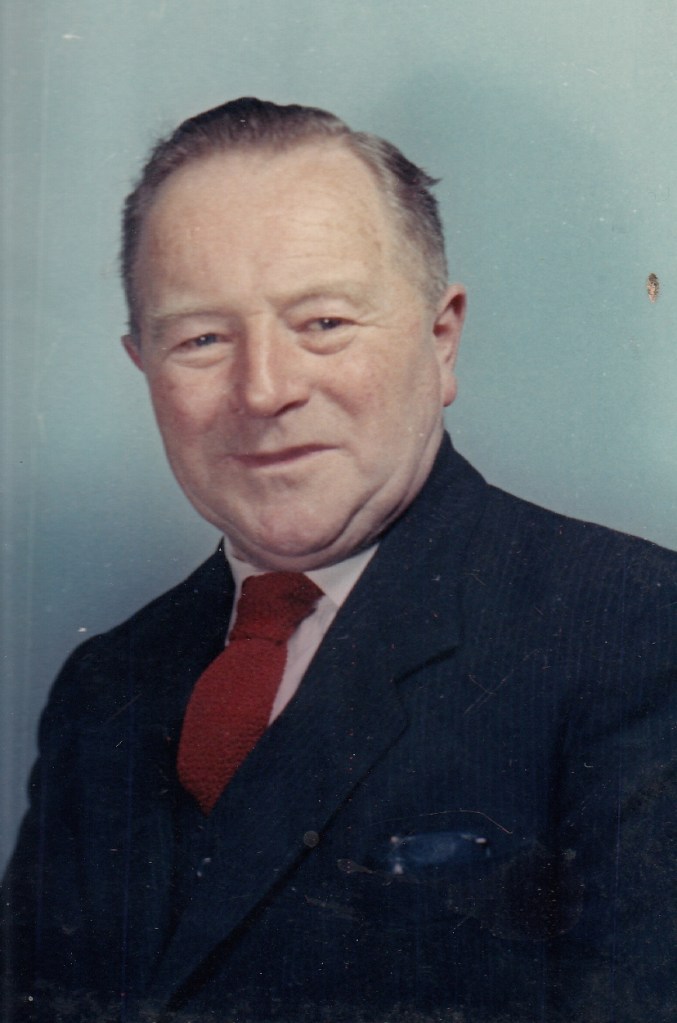
William J. Morgan (1902–80)
Headmaster of the Cardigan Junior School, 1931–1968. Previously schoolmaster at Ferwig Primary school. Town councillor, 1937–1952. Mayor in 1942, alderman in 1949. Appointed deacon at Bethania Chapel in 1937.
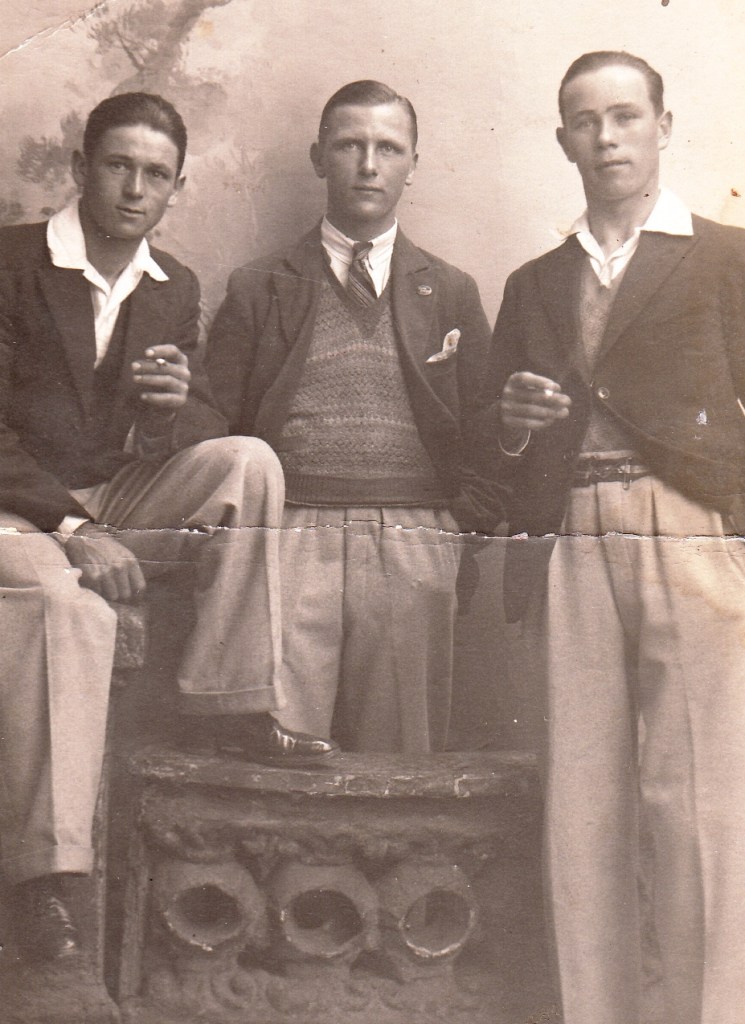
Richard Fugle [d.1945?], Arthur Davies, Mr. ?Sneade
Richard Fugle and Arthur Davies’ s names appear on the town Cenotaph. [More to come…]

Mrs Gwladys Llewelyn, Dolwerdd (1886–1977)
wife of Thomas Llewelyn, Dolwerdd, chemist, High St.
Cardigan People 22: Goronwy Moelwyn-Hughes MP (1897–1955)

Goronwy Moelwyn-Hughes was born in Priory St* on 6 October 1897 the eldest son of the Revd J. G. Moelwyn-Hughes (1866–1944) who was the minister at Tabernacle Chapel. He attended the local schools before heading for UCW Aberystwyth. During WW1 he served with the West Yorkshire regiment, was wounded , transferred to the Royal Flying Corps and served as a pilot (1917–19). He then returned to Aberystwyth, graduated as BA, entered Downing College, Cambridge where he obtained first-class honours in the law tripos. He was called to the bar in 1922. He fought two unsuccessful general elections for the Liberals in the Rhondda in Nov 1934 and Cardiganshire in 1935. He was the elected unopposed at a by-election in Carmarthen in March 1941, a seat he held until 1945. He was then returned as Labour MP for North Islington in 1950 but retired due to ill health in 1951.
He was appointed as a commissioner for inquiry on to the Burnden Park, Bolton football disaster in 1946, when 33 spectators were crushed by the pressure of numbers. He recommended that football grounds be made subject to safety licensing.
*[Llwyn Onn according to the Oxford Dictionary of National Biography, but according to 1901 Census Finch’s Sq. The family were living at Glasynys, Priory St. in 1911 (census)]
He frequently returned to Cardigan to visit his parents. Here is an interesting (silent) film he made of his visit in 1933.
https://player.bfi.org.uk/free/film/watch-haf-1933-cardigan-1936-online
Cardigan People 21: Dr William Bevan-Lewis (1847–1929)

Born at Cardigan 21 May 1847, to William Thomas Lewis (formerly of Trefgarn, Pembrokeshire) and Jane (Mansel Bevan) his wife. William Thomas (the father) was a tailor and draper at no. 9 High St. William B. was the third of 5 children.
He was educated at Cardigan and then Guy’s hospital in London. He obtained his MRCS, LRCP and LSA in 1868. He practised medicine at Burry Port for four years, and then joined the staff of the West Riding Asylum at Wakefield, where he remained for thirty-five years, eventually becoming its medical director. For twenty-five years, too, he was connected with what has now become the University of Leeds, and latterly was professor of mental diseases there.
According to Sir James Crichton-Brown, writing in the British Medical Journal after his death in 1929:
“Dr William Bevan-Lewis was one of the most diligent and productive of labourers in the field of medical psychology in this country during the last quarter of the last century and the first decade of [20th c.]
“After completing his studies at Guy’s Hospital… he became assistant medical officer at the Buckingham County Asylum… “ but after 2 yrs returned to Cardigan to begin private practice. “He soon found that his occupation in a mountainous district of Wales (sic!) was uncongenial, and left him no opportunity for the research work in which he earnestly desired to engage”
[At least he didn’t say he came from the Valleys!]
He began work at the West Riding Asylum in 1875.
He was the author of a number of text-books and publications on mental disease, including:
- Human Brain, Histological and coarse methods of research (1882)
- Textbook of the Mental Diseases with special reference to the pathological aspects of insanity (1889)
- and the section devoted to the general pathology of the nervous system in Allbutt’s System of Medicine.
Some of these books are in print and available to buy on Amazon…
Bevan-Lewis received the honorary M.Sc. degree of the University of Leeds in 1905, and was president of the Medico-Psychological Association in the same year.
The value of his work has been fully appreciated by his own specialty at home and abroad, and has been widely recognized by the profession at large. One of the gentlest and most unobtrusive of men in an age when notoriety is the universal quest, Bevan-Lewis persistently kept himself in the background.
He died on 14 October 1929, at the age of 82 years.
When you walk pass no. 9 High St. remember Dr Bevan-Lewis.
Maybe it’s time for a blue plaque!
Cardigan People 19: Edward Vernon Mathias – Memoirs of a Cardigan P.O.W. 18826

18826 Memoirs of a P.O.W. during the years 1940–45, Edward Vernon Mathias.
Available to download on to your Kindle
Only £3.06 to download. All proceeds to be donated to the British Legion Organisation.
Before the war Vernon Mathias (Mr Mathias, Bon Marche) worked at John Lewis, Oxford Street in London. At the beginning of WW2 he joined the Queen Victoria Rifles Regiment. By May 1940 he was on his way to France. He saw action in and around Calais, was wounded and was captured. There followed a 5 year term of imprisonment at several camps eventually ending up in a POW camp in Poland. His detailed and honest account describes daily life in a POW, the hardships and hopes for a better future back in Cardigan.
“We moved off stumbling over the railway lines, a stinking, dirty and dishevelled mob…”
“the Red Cross food parcel was the one thing that we looked forward to…”
“Physically I lost weight in a rapid an alarming manner and the side effects were weakness, an outbreak of skin sores, loss of some teeth and worst of all, one’s weakness encouraged the infestation of body lice which practically made life unbearable”
In the camp he meets up with another Cardigan boy – Jack Griffiths!
Autumn stretches out to winter: “The river Vestula froze to a great depth…”
“The frosty nights were marvellous and I would look at the stars and imagine Nan (later his wife) also looking at the same stars…”
He is then moved to Heydebreck. 1941 …1942… and 1943 beckons and life was hard – digging trenches while air raids were common especially throughout the summer of 1942. Then arrived a new medical officer – a Capt. James, originally from New Quay… (He died in 1981). There follows a failed attempt to escape from the camp… but leading only to (eventually three periods) of solitary confinement “ the room was roughly 6ft by 10ft…”
“1943 gradually came to a close and Christmas was here again…”
“whilst we POWs grumbled over our lot, it was as nothing compared to what the Jews suffered…”
22 January 1945 the march to freedom began, fleeing the Russian advance. After weeks of marching he eventually reached Burgermeistr, Bavaria.
“We flew home via Holland…when I arrived in Carmarthen railway station there was a taxi waiting for me. It took me the last 30 miles to Cardigan arriving in the evening where quite a few people were waiting to welcome me. My sister and my parents were waiting at the front door.”
“My journey was over” and it was time to look to the future.
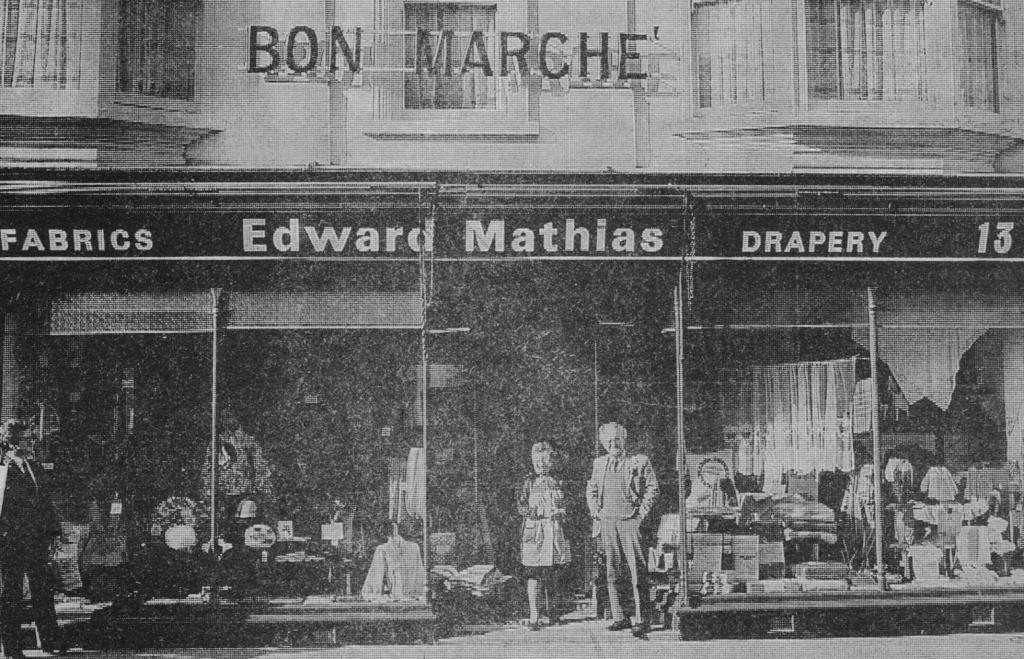
A fascinating account of what life was like as a prisoner of war.
Cardigan People 18: Tom Evans MA, JP at the VE Day Celebrations 1945
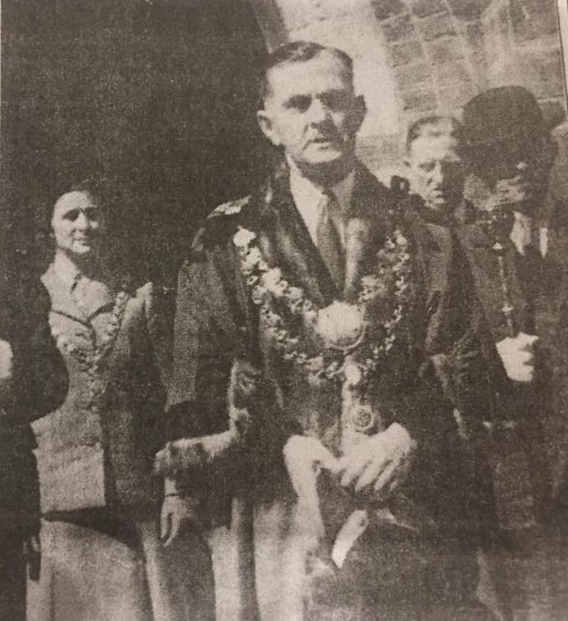
Cardigan People 17: Dr James M. Phillips; Dr Llewellyn C. P. Phillips

Dr James Mathias Phillips M.D., M.R.C.S., L.S.A. (1839–1903)
Native of St Dogmaels. In 1870 he was surgeon to Morfa Colliery, Margam. Returned to Cardigan during the 1880s. Lived and worked from 10 Priory St. Mayor in 1882. By 1901 he was living in Bank House, 6 High St. Baptist, member at Blaenwaun, Buried at Blaenwaun. His son Llewellyn Caractacus Powell Phillips was also a doctor (see below).
Dr Llewellyn Caractacus Powell Phillips M.A., M.D., F.R.C.P., F.R.C.S. (1871–1927):
| This is what the British Medical Journal has to say about him: He was born at Taibach, Glam. on July 28th 1871. In 1881 he was living in 10 Priory St. From Epsom College he went to Caius College, Cambridge, in 1889, obtaining first-class honours in Part I of the Natural Science Tripos of 1892, and then entered as a student at St Bartholomew’s Hospital. He qualified as MRCS, LRCP, in 1894, took the MB and B.Ch Camb degrees, in 1895, and in 1897 obtained diploma of FRCS Eng. In 1903 he proceeded MD and obtained MRCP and in 1909 elected Fellow of the Royal College of Physicians of London. He practised for a while at Cardigan. (c.1898) His career in Egypt began when he was appointed resident surgical officer of the Kasr-el-Aini Hospital Cairo. Elected Professor of Medicine in the Royal School of Medicine, Cairo. During WW1 he held a temporary commission as lieutenant-colonel RAMC, and commanded the British Red Cross Hospital at Giza; he was mentioned four times in dispatches. From 1914 to 1917 he held the appointment of physician to H.H. la Hussein Kamel, Sultan of Egypt, and for his services was made a member of the Orders of the Nile and of the Medjidie. He made a remarkable collection of old Arab glass weights and coins, and died at his house in Cairo in January, 1927. He contributed articles on tropical medicine to various medical journals including: “Phlebotomus Fever” in Bryan and Archibald’s Practice of Medicine in the Tropics, v Amoebiasis and the Dysenteries, 8vo, London, 1915. There is a plaque in memory of this gentleman in St Mary’s Church: https://www.geograph.org.uk/photo/6273412 |
Cardigan People 16: Ada Ince Williams; Revd William Jones; David J. P. Richards; Dr Selby Clare
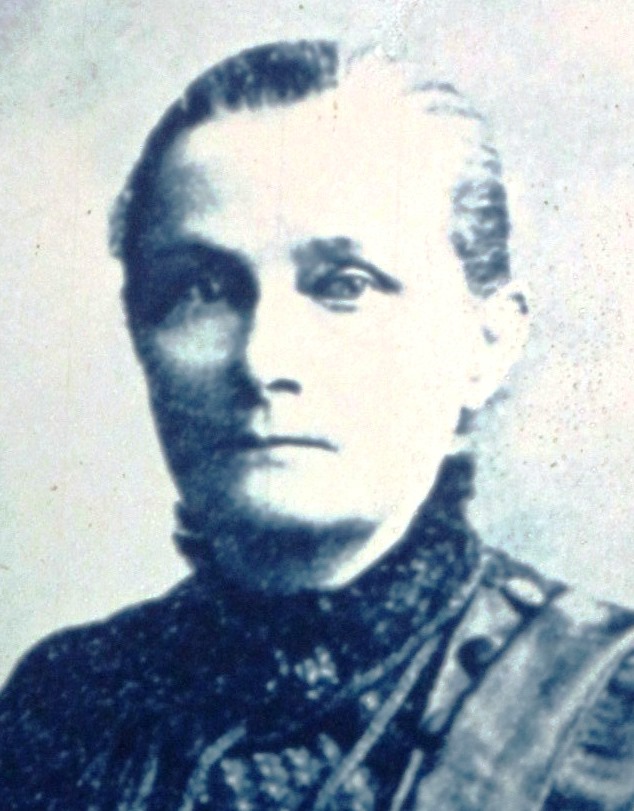
Ada Ince Williams (1856–22.09.1923)
Native of Haverfordwest. Lived in Northgate Terrace. Wife of Captain Thomas Howell Williams.

Revd William Jones, Tabernacle (1817–07.01.1892).
Lived at Glasgow House, Pendre. Borough mayor.
Revd William Jones 2
David J. P. Richards: ‘One of Wales’ premier distance walkers of his generation‘
David J. P. Richards, son of Capt David & Annie Ida, Kelvin, St Mary’s Terrace. His brother George Ivor Milton Phillips was killed on 26.03.1917 at the First Battle of Gaza [David Griffiths, Cenotaph, p. 92]
Member of Newport Harriers. Holder of the Welsh 2-mile walk title [South Wales Argus] and 15-mile walk title for 3 yrs in succession in 2h 5m 8sec. A Welsh record for the distance. [CTA 19.8.38].
As a 42 yr old he won the Monmouth open road walk of 14 miles in 2h 6m 2sec. – only 15 sec outside the record of W S Woode in 1936. [CTA 17.6.1938]. Any Photos survive?

Dr Selby Clare (7.08.1880–11.11.1942)
Graystone, Priory St.
Cardigan People 15: Arthur Morris; H. H. Evans; Ivor Rees; Charles Mason; Fred Lewis

Arthur Morris (1908–1937)
Cardigan Man Dies Fighting for Spanish Government
Arthur David Morris grew up at Claverley, 2 Gordon Terrace, the son of Arthur Owen and Martha Jane (nee Wigley) and worked as an apprentice at James’ ironmongery at Pendre. In 1929, at the age of 21, he emigrated to Canada. He served in the army for two and half years before he eventually settled in Blairmore, Alberta, where he worked as a miner. He joined the Communist Party of Canada in 1933.
Arthur Morris left Canada in 1936 to enrol in the International Lenin School in Moscow. After the outbreak of the Spanish Civil War the students of the Lenin School departed for Spain, and Arthur made his own way across Europe sending postcards home from Warsaw, Paris and Perpignan. He crossed into Spain and joined the American contingent who were forming the Abraham Lincoln battalion at Albacete, midway between Madrid and Valencia.
The battle that raged in the Jarama Valley to the south of Madrid in February 1937 was one of the most ferocious of the war with the Fascists deploying German artillery.
In February 1937, at the age of 29 Arthur Morris met his death in the olive groves of the Jarama Valley, south of Madrid.
In May 1937 news of Arthur’s death finally reached his mother and made front page headlines of the Tivyside Advertiser, competing for space with the Coronation; ‘Killed in Spain –Cardigan Man Dies Fighting for Spanish Government’. His mother described him as a “beautiful boy, always fighting for what he thought to be right”.

Henry Harries Evans (1872–14.05.1916, aged 45 yrs.)
A native of Solva, he moved to Cardigan when he was 20 years old. He was a bootmaker by trade. His workshop was in 8 St. Mary’s St. He was an excellent music teacher and conducted the Cardigan Choral Society for many years. He was also an accomplished artist in oil and watercolour. He composed a number of hymn-tunes for the local Singing Festivals e.g. Ar ei ben bo’r goron (1913); Cyfaill plant bychain (1909); Dewi (1914); Felinganol (1913); Induna (1913); Strathmore (1915); Ynys Dewi (1914). He disagreed with the decision to postpone the 1915 Cymanfa Ganu and strangely was buried on the very day that it was originally arranged to be held.

Ivor Rees (1935–84)
A native of St Dogmaels. Lived in Charlton House, North Rd. Local postman, and a keen sportsman – golf, snooker, football, and cross-country running. He played left back and was captain for Cardigan Town FC during its most successful period.

Charles Alfred William Mason (1900–82)
Born in Westminster. Fought with the 13th Royal Fusiliers during WW1. Joined the staff of the British Museum in 1922. Moved to Cardigan in 1956 with his wife Frances. They kept a second-hand bookshop at the Royal Oak, 1 Quay St.

Frederick David Lewis (d. Jan. 1983)
A native of Llandrindod Wells. Came to Cardigan in 1929. Amateur actor, Town Councillor, and mayor in 1952–3. A keen fisherman he kept a fishing tackle shop in Pendre. Accomplished golfer and excellent billiard player.
Cardigan People 14: Willie Morgan, Daniel Morris, Revd T. J. Morris, William A. Jenkins, John Evans
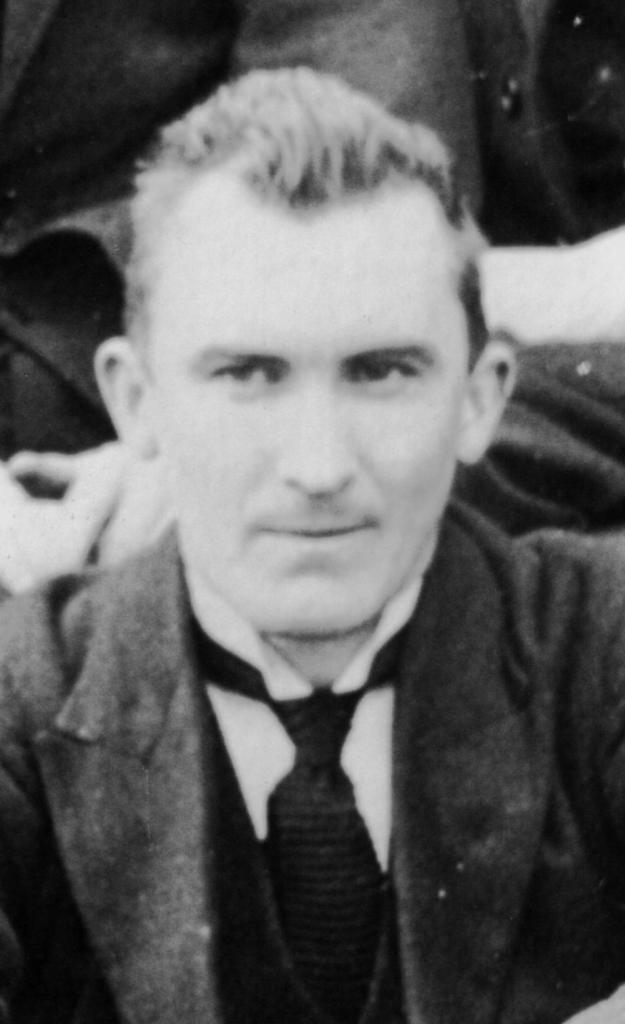
Willie Morgan, Adelphi (1904–87)
Confectioner and cafe at Adelphi, Pendre in the late 1950s and early 1960s. Sunday school teacher at Bethania Chapel.

Daniel Morris, Llwynpiod (14.08.1876–1953)
Dairy farmer. Keen agricultural showman and judge.

Revd T. J. Morris, Capel Mair (10.02.1846–13.12.1908)
A native of Llanelli. Entered Carmarthen College in 1867. Ordained in Saron, Llangeler in 1871. Began his ministry in Capel Mair in June 1876, with a membership of 327. The chapel developed as a cultural and social centre traditionally associated with late 19c nonconformity. A vestry was built in 1885. He married Elizabeth, the daughter of James and Elizabeth Herring in 1876. James Herring was the son of Revd John Herring, Bethania (1811–32).

William A. Jenkins, Mercantile. (d.02.02.1982)
Managing director of the Cardigan Mercantile Company. Town councillor. Mayor in 1966.

John Evans (1838–1903) (left)
Born on the Netpool. Boot and shoemaker in Pendre. Baptised 31.07.1892 by Revd John Williams, Bethania. He was a brother to Thomas (Telynog).
Cardigan People 13: Where’s Dai? Jan. 1936

I have enlarged the above photograph and divided it into sections to make it easier to see the faces. Please let me know if you recognize anyone (all suggestions welcomed).

1 William Jones (Willie Binks); 2 Nancy May Williams, Feidrfair; 3 ?

1 J G Watts; 2 John R. Daniel; 3 ?Bill Shewring; 4 Alec Richards, Feidrfair; 5 Golwyna Davies, Bron-y-dre; 6 Marjorie Owen, Cardigan Arms

1 Gwilym Prosser, Royal Stores; 2 ?

1 William Adams, Priory St; 2 Aneurin Jones, printer; 3 David Jones, Tivy-side; 4 Maida Rotie, St Mary’s St; 5 Gwladys Rotie, St Mary’s St; 6 John Prosser, Bron-y-dre; 7 Capt. Ladd, Aden Wen

1 Miss Davies, North Rd; 2 Dai Williams, Rosario Hall

1 Wynford Williams; 2 Trevor Williams, Pav; 3 Roland Peregrine, headmaster; 4 Nellie Sulman; 5 Margaret Sulman; 6 Revd D. J. Roberts, Capel Mair; 7 Vicar; 8 Pegi Rogers, Drawbridge
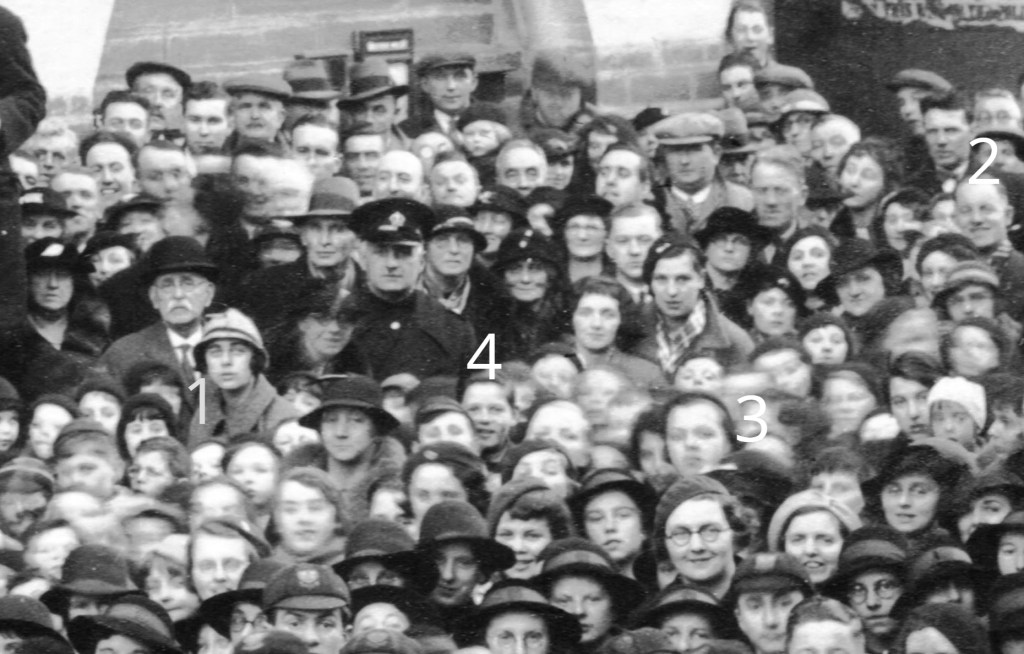
1 Miss Gwyneth Morris, headmistress; 2 George Evans, Hardware Stores; 3 Marie Smith; 4 Laurie Morgan


1 Revd D. J. Roberts, Capel Mair; 2 Vicar; 8 David J. Rotie, mace bearer; 12 Dan Williams, Y Bwthyn; 14 Revd Eseia Williams, Bethania; 19 Mrs James Thomas, Commercial, mayoress; 20 James Thomas, Commercial, mayor
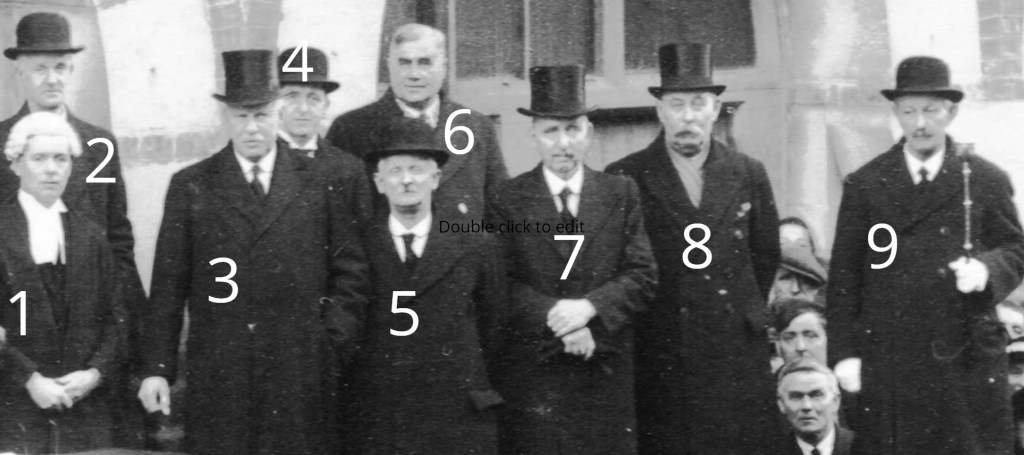
5 David Williams, Greenfield Row; 9 John Williams, mace bearer





